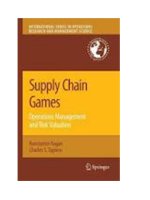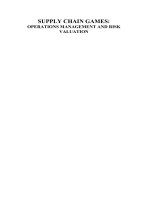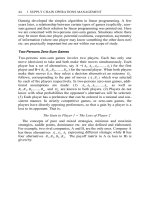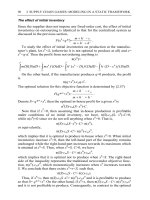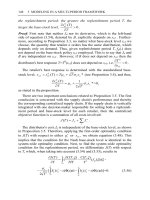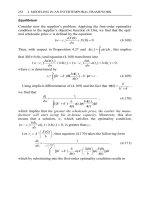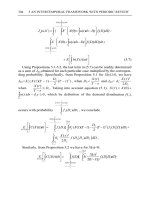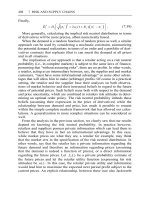Towards supply chain risk analytics
Bạn đang xem bản rút gọn của tài liệu. Xem và tải ngay bản đầy đủ của tài liệu tại đây (4.1 MB, 419 trang )
Iris Heckmann
Towards Supply
Chain Risk Analytics
Fundamentals, Simulation, Optimization
Towards Supply Chain Risk Analytics
Iris Heckmann
Towards Supply
Chain Risk Analytics
Fundamentals, Simulation, Optimization
Iris Heckmann
Karlsruhe, Deutschland
Von der Fakultät für Wirtschaftswissenschaften des Karlsruher Instituts für Technologie
(KIT) genehmigte Dissertation.
Tag der mündlichen Prüfung: 26.10.2015
Referent: Prof. Dr. Stefan Nickel
Korreferent: Prof. Dr. Francisco Saldanha-da-Gama
Prüfer: Prof. Dr. Wolf Fichtner
Vorsitzender: Prof. Dr. Rudi Studer
ISBN 978-3-658-14869-0
ISBN 978-3-658-14870-6 (eBook)
DOI 10.1007/978-3-658-14870-6
Library of Congress Control Number: 2016945784
Springer Gabler
© Springer Fachmedien Wiesbaden 2016
This work is subject to copyright. All rights are reserved by the Publisher, whether the whole or part
of the material is concerned, specifically the rights of translation, reprinting, reuse of illustrations,
recitation, broadcasting, reproduction on microfilms or in any other physical way, and transmission
or information storage and retrieval, electronic adaptation, computer software, or by similar or
dissimilar methodology now known or hereafter developed.
The use of general descriptive names, registered names, trademarks, service marks, etc. in this
publication does not imply, even in the absence of a specific statement, that such names are exempt
from the relevant protective laws and regulations and therefore free for general use.
The publisher, the authors and the editors are safe to assume that the advice and information in this
book are believed to be true and accurate at the date of publication. Neither the publisher nor the
authors or the editors give a warranty, express or implied, with respect to the material contained
herein or for any errors or omissions that may have been made.
Printed on acid-free paper
This Springer Gabler imprint is published by Springer Nature
The registered company is Springer Fachmedien Wiesbaden GmbH
Acknowledgments
The pursuit of well-sophisticated solutions, derived from theory and
made applicable in practice, led me to FZI Research Center for Information Technology. At FZI I was given the opportunity to work
on improvements for logistics systems, to learn technical content, to
get to know real-world problems and to experience a fruitful working
environment.
During that time I worked on the topic of Supply Chain Risk which
resulted in the underlying thesis. However, this work would have
not been possible without the support and guidance of others, who
I want to thank here.
I am indebted to Prof. Stefan Nickel for being the supervisor of
this thesis and a mentor to my research work – especially for his
farsighted guidance, his productive ideas, and his sincere interest in
discussing (rebutting or exploring).
My thanks also go to Prof. Francisco Saldanha-da-Gama for being
the co-supervisor of this work – for his calm, his profound thoughts
and his ability to explain.
Thanks are due to Prof. Wolf Fichtner for being part of the examination committee and to Prof. Rudi Studer for his sincere conduct
as the chairman of the examination committee.
Additionally, I thank my colleagues at the Logistics and Supply
Chain Optimization Group at FZI, the Institute of Operations Research (IOR) as well as the Institute for Material Handling and Logis-
VI
tics (IFL) of the KIT – Karlsruhe Institute of Technology for sharing
good and bad research times.
Priceless support and patient encouragement came from my family
and friends. They all have never become tired to encourage me.
Special thanks go to my parents, who have continuously offered me
a quite and safe place for retreat.
Abstract
Unexpected deviations and disruptions, those are subsumed under
the notion of supply chain risk, increasingly aggravate the planning
and optimization of supply chains. Over the last decade there has
been a growing interest in including risk aspects for supply chain
optimization models. This development has led to the adoption of
risk concepts, terminologies and methods defined and applied in a
broad variety of related research fields and methodologies. However,
for the purpose of supply chain risk management the suitability of
risk, as it is coined in these domains, is up for discussion.
The major contribution of this thesis is given by the development
of a profound conceptual basis of supply chain risk analytics and
the transfer of newly defined concepts for the modeling and operationalization of supply chain risk within simulation and optimization
approaches.
The first part gives an extensive analysis of fundamental concepts
and approaches that surround research in the field of supply chain
risk management. This includes a review of available concepts of risk
in general and supply chain risk in particular. As supply chain risk
is either ambiguously or incompletely defined the literature review
does not only critically revise existing approaches, but also identifies
essential aspects that drive the extent of supply chain risk. Part I
provides adjustments of commonly used concepts and offers a new
definition of supply chain risk. It is emphasized that it is the responsibility of supply chain risk analysis to evaluate the interactions
of risk defining elements. Having set the foundation for future approaches the new concept of supply chain risk analytics is coined.
VIII
Using mathematically based approaches, supply chain risk analytics
is tailored for the management of supply chain risk and associated
sub themes. A discussion of the value of mathematically approaches
in the light of risk-aware solutions and a review of existing literature
within the field of operations research complete Part I.
Consistently following the discussions and conclusions provided in
Part I, Part II introduces a new simulation-based procedure for identifying and assessing supply chain risks for a given supply chain, denoted by SimSCRF. The approach builds on existing proprietary supply chain planning engines and applies methods from design of experiments to determine weaknesses of the underlying supply chain. To
align the data model for supply chain planning with the simulationbased representation of a given supply chain, an object-oriented information framework is presented. The introduction of an additional
layer between planning engine and analysis algorithms offers the possibility to easily switch between different planning engines and as a
result conduct risk analysis for different supply chain planning problems. An exemplary supply chain risk analysis is conducted on a real
case supply chain originating from the chemical industry. The evaluation provides insights on the existence of supply chain risk and its
extent as well as on potential conclusions for mitigation options.
While the solution approach of Part II is characterized by the interplay of technical entities within a consistent process flow, Part
III focuses on the development of a risk-aware optimization model
for supply chain network design problems. Based on contemporary
research gaps identified for optimization approaches in Part I, Part
III deduces a mixed-integer two-stage stochastic programming model
that extends the capacitated plant location problem and additionally
offers the possibility to formalize and operationalize supply chain risk.
With the goal to evaluate risk-aware solutions the concept of value
of risk consideration is defined. The evaluation of the developed optimization model discloses its usefulness in terms of providing riskaware solutions and of approaching risk by stochastic programming
principles.
Contents
Abstract
VII
List of Figures
XV
List of Tables
XXI
1 Introduction
1.1 Motivation for Beginners . . . . . . .
1.2 Advanced Risk . . . . . . . . . . . .
1.3 The Real Introduction: The Name of
1.4 Outline and Course of Discussion . .
I
. . . . . .
. . . . . .
the Game
. . . . . .
.
.
.
.
.
.
.
.
.
.
.
.
Supply Chain Risk Concepts – Fundamentals
2 The Genesis of Supply Chain Risk
2.1 Logistics Innovations – A Blessing and a Curse
2.2 Supply Chain Disruptions . . . . . . . . . . . .
2.2.1 Environmental Disruptions . . . . . . .
2.2.2 Economic Disruptions . . . . . . . . . .
2.2.3 Socio-Geopolitical Disruptions . . . . .
2.2.4 Technological Disruptions . . . . . . . .
2.3 Coping with Risk . . . . . . . . . . . . . . . . .
2.3.1 Enterprise Risk . . . . . . . . . . . . . .
2.3.2 Following the footsteps of Management
.
.
.
.
.
.
.
.
.
.
.
.
.
.
.
.
.
.
1
1
5
8
12
17
.
.
.
.
.
.
.
.
.
19
20
23
29
30
33
34
35
35
37
X
Contents
2.3.3
Identification needs Quantification – Quantification needs Definition . . . . . . . . . . . . .
40
3 A New Definition of Supply Chain Risk
3.1 The Evolution of Risk . . . . . . . . . . . . . . . . .
3.2 Requirements for a Definition of Supply Chain Risk
3.3 Existing Approaches of Supply Chain Risk Definitions
3.4 Core Characteristics of Supply Chain Risk . . . . . .
3.4.1 Risk Objective . . . . . . . . . . . . . . . . .
3.4.2 Risk Exposition . . . . . . . . . . . . . . . . .
3.4.3 Risk Attitude . . . . . . . . . . . . . . . . . .
3.5 Re-defining Supply Chain Risk . . . . . . . . . . . .
43
45
47
48
50
52
56
72
74
4 Supply Chain Risk Analysis
4.1 The Risk of Supply Chain Risk Analysis . . . .
4.1.1 Biases of Risk Identification . . . . . . .
4.1.2 Biases of Risk Countermeasures . . . . .
4.1.3 Breaking of Biases . . . . . . . . . . . .
4.2 Main Elements of Supply Chain Risk Analysis .
4.2.1 Analysis of Potential Triggers . . . . . .
4.2.2 Analysis of Performance Measurement .
4.2.3 Analysis of Supply Chain Constitution .
4.3 Tasks of Supply Chain Risk Analysis . . . . . .
.
.
.
.
.
.
.
.
.
.
.
.
.
.
.
.
.
.
5 Supply Chain Risk Analytics
5.1 Supply Chain Risk Analytics – Concept Definition
5.2 The Value of Supply Chain Risk Analytics . . . . .
5.2.1 Risk Acceptance . . . . . . . . . . . . . . .
5.2.2 Risk Reduction Measures . . . . . . . . . .
5.2.3 Risk Spreading Measures . . . . . . . . . .
5.3 Quantification Measures for Supply Chain Risk . .
5.3.1 Deviation Measures . . . . . . . . . . . . .
5.3.2 Downside Risk . . . . . . . . . . . . . . . .
5.3.3 Expected Values . . . . . . . . . . . . . . .
5.3.4 Probability and other measures . . . . . . .
.
.
.
.
.
.
.
.
.
77
79
83
88
95
96
96
107
117
127
.
.
.
.
.
.
.
.
.
.
131
132
135
137
140
149
152
153
153
154
155
Contents
5.4
5.5
XI
Risk-aware Supply Chain Optimization .
5.4.1 Modeling Approaches . . . . . .
5.4.2 Solution Techniques . . . . . . .
Research Gaps . . . . . . . . . . . . . .
.
.
.
.
.
.
.
.
.
.
.
.
.
.
.
.
.
.
.
.
.
.
.
.
.
.
.
.
157
158
161
161
II Supply Chain Risk Identification and Assessment – Simulation-based Framework
163
6 Simulation for Supply Chain Analysis
6.1 Simulation at a Glance . . . . . . . . .
6.1.1 Basics . . . . . . . . . . . . . .
6.1.2 Technical entities of Simulation
6.1.3 Simulation Paradigms . . . . .
6.2 Simulation of Supply Chain Problems
6.3 Simulation and Optimization . . . . .
. . . .
. . . .
Tools
. . . .
. . . .
. . . .
.
.
.
.
.
.
.
.
.
.
.
.
.
.
.
.
.
.
.
.
.
.
.
.
7 Design, Metamodeling, and Analysis of Simulation
Experiments
7.1 Meta-Models . . . . . . . . . . . . . . . . . . . . . .
7.2 Designs . . . . . . . . . . . . . . . . . . . . . . . . .
7.2.1 Purpose of Design . . . . . . . . . . . . . . .
7.2.2 Classic Factorial Designs . . . . . . . . . . . .
7.2.3 Design construction . . . . . . . . . . . . . .
7.3 Analysis . . . . . . . . . . . . . . . . . . . . . . . . .
7.3.1 Regression Analysis . . . . . . . . . . . . . .
7.3.2 Method of Least Squares . . . . . . . . . . .
7.3.3 Analysis of Variance (ANOVA) . . . . . . . .
7.3.4 Measures of Factor Effects . . . . . . . . . . .
7.4 Illustrative Examples . . . . . . . . . . . . . . . . . .
7.4.1 A 24 Full Factorial Experiment for the Analysis of Production Characteristics . . . . . . .
7.4.2 A 24−1
IV Fractional Factorial Experiment for the
Analysis of Production Characteristics . . . .
7.5 Cautions with the Design of Experiments . . . . . .
165
167
167
171
172
175
176
181
184
187
188
193
196
198
199
200
202
202
206
206
211
213
XII
Contents
8 A Simulation-based Approach for Supply Chain Risk
Analysis
8.1 Requirements . . . . . . . . . . . . . . . . . . . . . .
8.2 A New Approach for Supply Chain Risk Analysis –
Basic Models . . . . . . . . . . . . . . . . . . . . . .
8.2.1 Scenario-based Procedure . . . . . . . . . . .
8.2.2 Screening Procedure . . . . . . . . . . . . . .
8.2.3 Procedure for Risk Quantification . . . . . .
8.3 Summarized Main Features of the Approach . . . . .
9 Representative Master Planning Module for Supply
Chains
9.1 Planning Tasks of Supply Chains . . . . . . . . . . .
9.2 Mathematical formulation of a Master Planning Problem . . . . . . . . . . . . . . . . . . . . . . . . . . . .
9.2.1 Determinants . . . . . . . . . . . . . . . . . .
9.2.2 Objective Function . . . . . . . . . . . . . . .
9.2.3 Restrictions . . . . . . . . . . . . . . . . . . .
10 A Conceptual Information Meta-Model for Supply
Chains
10.1 Requirements for a Supply Chain Information MetaModel . . . . . . . . . . . . . . . . . . . . . . . . . .
10.2 Related Work . . . . . . . . . . . . . . . . . . . . . .
10.3 Modeling Supply Chain Information . . . . . . . . .
10.3.1 Concepts . . . . . . . . . . . . . . . . . . . .
10.3.2 Properties . . . . . . . . . . . . . . . . . . . .
10.3.3 Relations . . . . . . . . . . . . . . . . . . . .
10.3.4 Constraints . . . . . . . . . . . . . . . . . . .
10.4 A Supply Chain Model . . . . . . . . . . . . . . . . .
11 A Real Case Evaluation of the SimSCRF Approach
11.1 The Case . . . . . . . . . . . . . . . . . . . . . . . .
11.2 Contemporary Risk Quantification . . . . . . . . . .
11.3 A new View on Supply Chain Risk Analysis . . . . .
217
218
220
220
227
229
233
235
236
238
241
247
248
261
262
264
266
266
268
268
269
271
277
279
281
286
Contents
11.4 Supply Chain Risk Analysis . .
11.4.1 Work Flow . . . . . . .
11.4.2 Effect Analysis . . . . .
11.4.3 Risk Line Identification
11.5 Conclusions and Outlook . . .
XIII
.
.
.
.
.
.
.
.
.
.
.
.
.
.
.
.
.
.
.
.
.
.
.
.
.
.
.
.
.
.
.
.
.
.
.
.
.
.
.
.
.
.
.
.
.
.
.
.
.
.
.
.
.
.
.
.
.
.
.
.
288
288
300
303
308
III Strategic Supply Chain Risk Mitigation – Optimization Approaches
311
12 Embedding Comprehensive Risk
313
12.1 Mathematical Model Formulations . . . . . . . . . . 316
12.1.1 Notations . . . . . . . . . . . . . . . . . . . . 316
12.1.2 The Risk-aware Capacitated Plant Location
Problem (CPLP-Risk) . . . . . . . . . . . . . 319
12.2 Illustrative Example . . . . . . . . . . . . . . . . . . 327
12.2.1 Data Input . . . . . . . . . . . . . . . . . . . 328
12.2.2 Solution Plausibility . . . . . . . . . . . . . . 333
12.2.3 The Value of Risk Consideration . . . . . . . 339
12.2.4 Quantification of Supply Chain Risk . . . . . 343
12.3 Preliminary Computational Results . . . . . . . . . . 345
12.4 Model Extensions . . . . . . . . . . . . . . . . . . . . 354
12.4.1 Model Extensions for the Affected Supply
Chain . . . . . . . . . . . . . . . . . . . . . . 354
12.4.2 Model Extensions for the Risk Objective . . . 357
12.4.3 Model Extensions for the Risk Attitude . . . 358
12.5 Conclusions and Outlook . . . . . . . . . . . . . . . 360
13 Conclusions and Outlook
363
13.1 Conlusions . . . . . . . . . . . . . . . . . . . . . . . . 364
13.2 Outlook . . . . . . . . . . . . . . . . . . . . . . . . . 369
Bibliography
373
List of Figures
1.1
1.2
A supply chain example . . . . . . . . . . . . . . .
Outline . . . . . . . . . . . . . . . . . . . . . . . .
2.1
2.4
Global risks landscape – movements from 2012 to
2013 . . . . . . . . . . . . . . . . . . . . . . . . . .
Economic damage in US$ billion caused by reported
natural disaster (1975-2014) . . . . . . . . . . . . .
Risk perception and complexity of different logistics
systems . . . . . . . . . . . . . . . . . . . . . . . .
Process cycle of supply chain risk management steps
37
39
3.1
3.2
3.3
3.4
Analysis of supply chain risk definitions . . . . .
Core characteristics of supply chain risk . . . . .
Supply chain risk objectives . . . . . . . . . . . .
Literature analysis of supply chain risk categories
51
52
55
66
4.1
4.2
Formation of supply chain risk analysis . . . . . . .
81
Relationship between events and their related consequences . . . . . . . . . . . . . . . . . . . . . . . .
83
Graphical visualization of functional relation between
the set of identified supply chain risks and potential
mitigation options . . . . . . . . . . . . . . . . . .
89
Perspectives of supply chain risk management . . .
92
Traditional vs. risk-aware planning process . . . .
94
Relationship between events and their related consequences . . . . . . . . . . . . . . . . . . . . . . . .
97
Elements of uncertainty profiles . . . . . . . . . . . 101
2.2
2.3
4.3
4.4
4.5
4.6
4.7
.
.
.
.
9
14
27
31
XVI
4.8
4.9
4.10
4.11
4.12
4.13
4.14
4.15
4.16
5.1
5.2
5.3
5.4
5.5
5.6
5.7
5.8
List of Figures
Exemplary uncertainty profiles of supply chain factor values . . . . . . . . . . . . . . . . . . . . . . .
Uncertainty profiles of real-world supply chain factors
Exemplary uncertainty profiles of supply chain factor values influenced by different potential triggers
Functionality and profitability of supply chain processes affect efficiency and effectiveness . . . . . . .
Exemplary uncertainty profiles of supply chain factor values . . . . . . . . . . . . . . . . . . . . . . .
Acceptable performance deterioration levels of more
risk-averse and more risk-seeking decision makers .
Risk profiles . . . . . . . . . . . . . . . . . . . . . .
Levels of structural metrics indicating supply chain
resilience . . . . . . . . . . . . . . . . . . . . . . . .
Exemplary extracts of a supply chain and a bill of
material . . . . . . . . . . . . . . . . . . . . . . . .
Example of a supply chain . . . . . . . . . . . . . .
Example of a disruption propagating through the
entire supply chain . . . . . . . . . . . . . . . . . .
Impact of a disruption without supply chain risk
management . . . . . . . . . . . . . . . . . . . . . .
Development of performance and extra expenses in
the presence of a disruption when supply chain risk
management actions are not installed . . . . . . . .
Impact of a disruption in the presence of a disruption
when reactive countermeasures are installed . . . .
Development of performance and extra expenses in
the presence of a disruption when reactive countermeasures are installed . . . . . . . . . . . . . . . .
Impact of a disruption in the presence of a disruption
when flexible countermeasures are installed . . . .
Development of performance and extra expenses in
the presence of a disruption when flexible countermeasures are installed . . . . . . . . . . . . . . . .
103
104
106
108
112
114
116
119
121
136
137
139
140
143
144
145
146
List of Figures
5.9
5.10
6.1
6.2
6.3
7.1
7.2
7.3
7.4
7.5
8.1
8.2
8.3
8.4
8.5
8.6
9.1
9.2
9.3
9.4
9.5
Impact of a disruption in the presence of a disruption
when robust countermeasures are installed . . . . .
Measures applied for quantifying supply chain risk
Process steps of simulation . . . . . . . . . . . . . .
Technical components of a simulation . . . . . . . .
Causal and temporal classification of simulation and
optimization integrating approaches . . . . . . . .
Main elements of an experimental setup . . . . . .
Relationship between input factors and output variable of the system and its simulated meta-model .
A response surface and a corresponding contour plot
Interaction plots . . . . . . . . . . . . . . . . . . .
Residuals and normal probability plot of 24 factorial
experiment . . . . . . . . . . . . . . . . . . . . . .
Relationship between supply chain risk defining entities . . . . . . . . . . . . . . . . . . . . . . . . . .
Conceptual and simulation approach of a new supply
chain risk analysis approach . . . . . . . . . . . . .
Basic process flow of a new supply chain risk analysis
model . . . . . . . . . . . . . . . . . . . . . . . . .
Process flow of the screening procedure within the
supply chain risk analysis model . . . . . . . . . . .
Process flow of the risk quantification procedure . .
Risk line . . . . . . . . . . . . . . . . . . . . . . . .
Supply chain planning matrix . . . . . . . . . . . .
Software modules covering the SCP-matrix . . . .
Set of nodes . . . . . . . . . . . . . . . . . . . . . .
Visualization of the production and resource planning Variables . . . . . . . . . . . . . . . . . . . . .
Visualization of modeling logic for substitute products . . . . . . . . . . . . . . . . . . . . . . . . . .
XVII
147
156
170
172
178
182
185
192
210
215
222
223
225
228
230
232
237
239
240
249
253
XVIII
10.1
10.2
10.3
10.4
10.5
10.6
11.1
11.2
11.3
11.4
11.5
11.7
11.6
11.8
11.9
11.10
11.11
11.12
11.13
11.14
List of Figures
Concepts of the deduced information meta-model for
supply chains . . . . . . . . . . . . . . . . . . . . .
Link-node constraint . . . . . . . . . . . . . . . . .
Capability-activity-product constraint . . . . . . .
Conceptual modeling of the supply chain task transport . . . . . . . . . . . . . . . . . . . . . . . . . .
Conceptual modeling of the supply chain task production . . . . . . . . . . . . . . . . . . . . . . . .
Conceptual modeling of the supply chain task storing
Supply chain under investigation: physical view . .
Supply chain under investigation: product view . .
Relationship between frozen horizon, the emergence
of disruption information, and the start of modifications of supply chain factors . . . . . . . . . . . . .
Planning reports for the reference supply chain and
a single-scenario supply chain: network view . . . .
Planning reports for the reference supply chain and
a single-scenario supply chain: KPI view . . . . . .
User input aligned to the work flow of the SimSCRF
model . . . . . . . . . . . . . . . . . . . . . . . . .
Conceptual modeling of the supply chain task production (replicate) . . . . . . . . . . . . . . . . . .
Factor template for supply chain factor maximum
production capacity . . . . . . . . . . . . . . . . . .
Extract of the definition script for base data activity
amount . . . . . . . . . . . . . . . . . . . . . . . .
Extract of the definition script for base data activity
costs . . . . . . . . . . . . . . . . . . . . . . . . . .
Definition script for the performance indicator activity expenses . . . . . . . . . . . . . . . . . . . . . .
Visualization of risk line quantification (A) . . . .
Visualization of risk line quantification (B) . . . . .
Risk line for factor A and D . . . . . . . . . . . . .
267
269
270
274
275
276
280
282
290
291
292
293
294
296
298
299
300
304
305
307
List of Figures
12.1
12.2
12.3
12.4
12.5
12.6
12.7
12.8
The core characteristics of supply chain risk (CCSCR) hierarchy . . . . . . . . . . . . . . . . . . . .
Development of stochastic parameters . . . . . . .
Development of overall capacity (gray) and demand
(black) for the illustrative example . . . . . . . . .
Solution comparison of deterministic CPLP-T’ and
stochastic CPLP-RISK model . . . . . . . . . . . .
VSS and EVPI values for illustrative example with
different facility costs . . . . . . . . . . . . . . . . .
Development of VSS and EVPI values for illustrative
example with different facility costs . . . . . . . . .
Development of computation time and related VSS
of the illustrative example with different facility costs
Development of computation time of the stochastic
program and its deterministic counterpart of the illustrative example with different facility costs . . .
XIX
314
331
332
342
349
350
352
353
List of Tables
2.1
Opportunities and risks of prevailing logistics best
practices . . . . . . . . . . . . . . . . . . . . . . . .
Major disruptions from 1997 – 2011 . . . . . . . . .
22
29
3.2
3.3
3.4
Uncertainty model of uncertain parameter
ment . . . . . . . . . . . . . . . . . . . . .
Supply chain risk categories . . . . . . . .
Supply chain vulnerability definitions. . .
Risk attitudes considering approaches . .
develop. . . . .
. . . . .
. . . . .
. . . . .
58
63
68
73
4.1
Major disruptions and related countermeasures . .
91
5.1
5.2
5.3
5.4
Descriptive, predictive, and prescriptive analytics
Categorization of modeling approaches . . . . . .
Modeling approaches of the reviewed papers . . .
Solution techniques of the reviewed papers . . . .
6.1
6.2
Simulation: terms and definitions . . . . . . . . . . 168
Summary of major characteristics of three main simulation paradigms . . . . . . . . . . . . . . . . . . . 174
7.1
7.2
7.3
Design matrix of a 24 full factorial design . . . . .
Contrast constants for a 24 full factorial design . .
Effect estimates and sums of squares for the 24 factorial experiment . . . . . . . . . . . . . . . . . . .
Analysis of variance table . . . . . . . . . . . . . .
2.2
3.1
7.4
.
.
.
.
133
159
160
161
207
208
209
211
XXII
7.5
7.6
List of Tables
Experimental design matrices for a 24−1
IV fractional
factorial design . . . . . . . . . . . . . . . . . . . .
Effect estimates and sums of squares for the 24−1
IV
fractional factorial experiment . . . . . . . . . . . .
212
212
9.2
9.1
9.3
Decision variables of the supply chain planning model 243
Sets and indices of the supply chain planning model 244
Input factors of the supply chain planning model . 247
10.1
Property types deduced for the supply chain model
272
11.1
Experimental design matrices for the 24 factorial
screening analysis . . . . . . . . . . . . . . . . . . .
Results of the 24 factorial screening analysis . . . .
302
303
11.2
12.1
12.2
12.3
12.4
12.5
12.6
Sets and indices applied for the CPLP-T (c), CPLPT (cT ) and CPLP-RISK (cRisk ) model . . . . . . .
Deterministic and stochastic parameters applied for
the CPLP-T (c), CPLP-T (cT ) and CPLP-RISK
(cRisk ) model . . . . . . . . . . . . . . . . . . . . .
Decision variables for the CPLP-T (c), CPLP-T (cT )
and CPLP-RISK (cRisk ) model . . . . . . . . . . .
Deterministic parameters and their values for the
illustrative example . . . . . . . . . . . . . . . . . .
Solutions of capacity extensions decisions for the illustrative example with target service level of 100%
Solutions of capacity extensions decisions for the illustrative example with target service level of 95%
316
317
318
329
335
338
1 Introduction
“Have Patience.
All things are difficult before they become easy.”
Saadi
1.1 Motivation for Beginners
Most of us use the concept of risk frequently in daily language. “If
you decide to do this, you risk suffering negative consequences.” This
sentence can be referred to a discussion with a colleague at work when
talking about new business strategies, or with your partner when
reflecting on financial precautions or health care, or with yourself
when deliberating about whether to eat fish in a sushi restaurant.
But what exactly is risk? How can we value risk? How can risk
change our decisions? How can we improve our decisions through
the consideration of risk? How is risk actually assessed? In terms
of percentage? With the means of a linear scale form 1 to 10 or by
using an ample scale from green to red? For the beginning we start
with a comparison of different risk situations by using relative terms
such as “lower” or “higher”.
Imagine you want to assess the risk of not being able to deliver a
wedding cake to an exclusive restaurant, because you were seriously
© Springer Fachmedien Wiesbaden 2016
I. Heckmann, Towards Supply Chain Risk Analytics,
DOI 10.1007/978-3-658-14870-6_1
2
1 Introduction
injured by a car, when you cross the street without looking for approaching vehicles. We construct the circumstances that define this
situation in more detail as follows: Assume the road to be a main
through road of a small village in the back country. Generally, the
volume of traffic is high within the week early in the morning and in
the evening due to commuting, but it is only a small village such that
the car frequency is moderate. Four times a year a local car racing is
held in this region and the main through road of the village is part of
the route. The village youngsters have just recently got their driving
license and cruise through the village in the afternoons. Additionally,
the village is part of a field trial, whose overall objective is to reduce
CO2 -Emission. Each household is endowed with at least one electric
car, which are by far more quite than diesel- or petrol-engined vehicles. So, the probability of a car arriving just in the moment you
want to cross the street depends on the day of the year, the day of
the week and the time of the day. The probability of being hit by
an approaching car depends on your ear, your reaction, the driving
skills of the driver, and the weight of the cake. If you want to cross
the street on the day of the car race, the probability of being badly
injured is significantly higher compared to normal weekdays.
The analysis of probability is a standard mean to assess risk, but is
the risk of not delivering a wedding cake and being injured by a car
higher or lower, if crossing the street is one of a series of dozen tasks
that you have to pass as a participant of an extreme obstacle course?
This challenging run is of course illegal, but frequently attended by
extreme athletes from all over the world. Other obstacles on this run
include passing a gill on a slackline and ends with a base jump from a
rock. You are a person who can be described as an adrenaline junkie.
Passing a road without looking for cars is nothing you would call a
risk. Hence, the risk of not being able to deliver a wedding cake and
additionally getting injured is lower for you than for a person that
tackles tasks dutifully or a person suffering from the brittle-bone disease, who both try to avoid any danger, when passing a street.
How does the risk level change, if you are professional stunt-man just
delivering a wedding cake for your friend, who is a confectioner? You
1.1 Motivation for Beginners
3
are booked for years as a double for actors that have not the skills
nor the ability to ride a car accident out – especially not when having a wedding cake in their hands. You have been trained for years
to overcome situations in which fast approaching cars hit you. For
you, crossing the through road of a backwater town while delivering
a wedding cake does not pose a challenge – as long as it is not the
day of the car race. So the risk of not being able to deliver and being
injured is certainly lower for you than for a senior citizen. But it is
higher, if you are on the run from a rabid dog. The dog is wanted
for months as he has killed numerous animals in the neighborhood
and already attacked other people. When you started your delivery
walk at the urging of your friend and went through the fields nearby,
you startled the dog under a tree while he was eating a blackbird.
During your career as a stunt-man you have witnessed several stunts
with mad animals. You know that a confrontation with a mad or
even rabid animal can have serious consequences for your well-being,
which you want to avoid. The dog is fast and if you stop or slow
down before the road, he will certainly catch you. The restaurant
is located on the opposite side of the road, if you run across the
street (without looking), you will certainly find a shelter and be safe.
Your individual objective has changed and you now want to ensure
or maximize your physical inviolability, but you also try to deliver
your friends cake anyway. Nevertheless, crossing the street of a small
village is less dangerous than fighting with a rabid dog.
How does the risk level change, if your objective changes again?
What is the risk of being injured, when you are on the way to the
hospice? You had a great time as stunt-man, but those days have
long since passed. The last years you fought against a serious illness
and the doctors give you one or two months before your body will
lose this fight. During your stay at your friends house you decided
that it is time to give up. You are grateful for having such a good
friend that you comply with his demand to deliver the wedding cake.
When you passed the fields, you killed the rabid dog with a judo
chop and are now in thoughts while approaching the road on the day
of the car race. The risk of not being able to deliver the cake and
4
1 Introduction
being injured or even killed by a car is – with respect to what you
have to expect – considerable low.
And how does the risk of not being able to deliver a wedding cake
and being injured by a car while crossing the street of a backwater town change, if all the aforementioned thoughts do not apply to
your situation, because you are sitting on the veranda of your ranch
house in the outback of Australia just thinking about different types
of risk? As a child becoming a stunt-man has ever since been your
dream, but you decided to work as research scientist at university.
You wrote your PhD thesis about the concept of risk. A couple of
days before submission you were sitting on some stairs at the University, felt exhausted and thought of resigning. All of a sudden a
big nugget fell down on the street. You had no idea, where it came
from, but you felt blessed, finished your PhD and got a great amount
of money for this golden and heavy nugget. You bought this ranch
house in Australia, and became a dropout before you became a beginner. Now you are sitting on a rocking chair, looking over the
fields, and patting the head of your dog, who has an anti-rabies inoculation. Streets and cars are thousands of miles away. So, the risk
of not being able to deliver a wedding cake and being injured by a
car while crossing a street simply does not exist.
But how about the risk being not able to deliver a didgeridoo to Europe for the birthday party of your friend, because you were seriously
injured by a spider sized less than four centimeters while collecting
fire wood in Australia?
This constructed case demonstrates that the level of risk changes
with the perspective and seemingly depends on specific circumstances
that need to be known and evaluated prior to risk assessment. The
consideration of risk is often treated as exaggerated, while the risk
concept itself is almost always oversimplified. As incidents like the
European ash cloud in 2011, Fukushima-Daiichi nuclear disaster in
2011, or the airplane crash in the French Alpes in 2015 highlight,
reality is often more erratic and unimaginable than thinking up risk
scenarios.
1.2 Advanced Risk
5
1.2 Advanced Risk
In the last decade we witnessed numerous real cases of risk – smaller
and bigger ones. When these cases occurred we were stunned by
their consequences or implications. Force majeur or blow of fate?
How could it happen? Why were we not prepared? Why did we not
evaluate the situation correctly in advance? How can we prevent or
diminish such cases or their consequences?
We relate to some cases to evaluate in more detail the perspectives
introduced in the previous section, which co-determine the level of
risk. Certainly, probability is one major concept of risk. However,
when talking about probability we immediately enter a highly discussed field. People have been arguing about the meaning of “probability” for at least 200 years. The major polarization of the notion
is between the objectivist1 and subjectivist2 schools [171, 223, 325].
While objectivists believe that probabilities are real, subjectivists assume probabilities to reflect the degree of beliefs of rational persons.
When applied in the context of risk, probability needs to be carefully defined. While the objective probability of an ash cloud forcing
airplanes to stay on the ground was ever since equal to zero, there
was a certain plausibility, a subjective probability, we must affirm
at hindsight. Throughout this thesis we follow [146], who combines
both views and defines probability as subjective in the sense that it
describes a state of knowledge rather than any property of the real
world; but it is objective in the sense that it is independent of the
personality of the decision maker. Two rational beings faced with
the same total background of knowledge must assign the same probabilities.
Consider then the risk of a deadly airplane crash. Often people start
to argue that the probability of deadly accidents is extremely low
1
2
Other notions related to the “objectivist’s” perception of probability are “frequentist”, the “aleatory” or the “physical” notion of probability.
Other notions related to the “subjectivist’s” perception of probability are the
“Bayesian” or “evidential” notion of probability.
